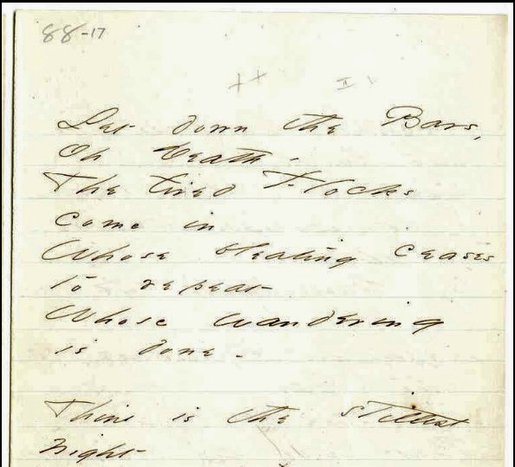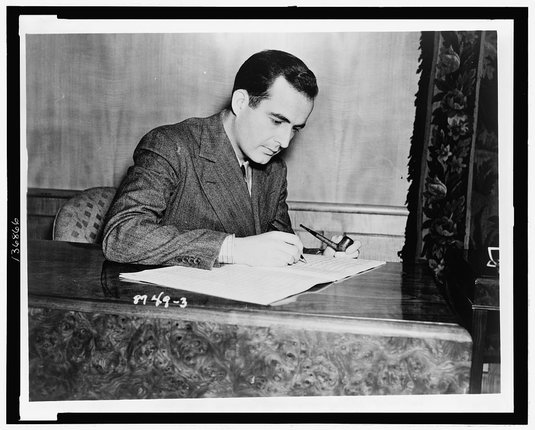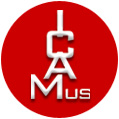Samuel Barber Complete Thematic Catalogue - Sibelius SCORCH files for Chapter 3. Young Composer in His Twenties.
Barber's score incipits for all the works composed in his twenties. Samuel Barber: A Thematic Catalogue of the Complete Works by Barbara B. Heyman, published by Oxford University Press; in the volume, all excerpts from the published and unpublished works of Samuel Barber are reprinted by permission of G. Schirmer, Inc., and the Samuel Barber Trust. Sibelius SCORCH files for Chapter 3: Works 1930-1939 (H-59 to H-94). This section includes the pieces Samuel Barber wrote as a young composer, among which the Adagio for Strings Op. 11, the Violin Concerto Op. 14, songs, as well as piano, chamber, orchestral, and choral works.

View and listen to the score incipits and relevant Sibelius SCORCH audio files of Samuel Barber’s Thematic Catalogue. The Table of Contents and the Index Numbers refer to Samuel Barber: A Thematic Catalogue of the Complete Works by Barbara B. Heyman (Oxford University Press, 2012). This online publication is an innovative ICAMus project carried out by special arrangement with Dr. Heyman and with the Publisher. Barbara Heyman is the author of Samuel Barber: The Composer and His Music (Oxford University Press, 1992).
* Note. If you are unable to view the Sibelius SCORCH files, please install the plug-in here. It is free and easy. The plug-in allows you to view and listen to the score incipits of Samuel Barber’s Thematic Catalogue, inclusive of all his early, rare, unpublished and incomplete compositions. The Sibelius score incipit for each work follows the title it refers to.
SAMUEL BARBER (1910-1981)
REGISTER OF INCIPITS
PART 3 (1930-1939) H-59 to H-94
H-59 Piano Concerto fragment. 1928-1930. Destroyed work.
H-60 Motetto on Words from the Book of Job. For chorus; 1930.
a. I, Adagio. Biblical text: Job III:17-19 [Barber incorrectly cites these lines as IV:17]. For chorus SATB.
b. II, Allegro non troppo. Biblical text: Job V:1. For chorus SATB.
c. IV, Allegro. Biblical text: Job XI:16. For double chorus SATB.
H-61 Legend, for carillon. Ca. 1931.
H-62 Two Interludes [Op. 4]. For piano; 1931-1932.
a. Interlude I
b. Interlude II
H-63 Dover Beach, Op. 3. Text by Matthew Arnold (1822-1888). For medium voice and string quartet; 1931.
H-64 Overture to The School for Scandal, Op. 5. For orchestra. 1931-1932.
a. Opening
b. Allegro molto e vivace
c. Second theme
H-65 Sonata for Violoncello and Piano, Op. 6. 1932.
I. Allegro ma non troppo
II. Adagio—Presto di nuovo—Adagio
III. Allegro Appassionato
H-66 Suite for Carillon. 1932.
I. Adagio
II. Scherzetto: Allegro vivace
III Andante un poco mosso
IV Finale: Allegro molto
H-67 Three Pieces for Carillon. 1931-1933.
I. Round: Allegro
II. Romanza:Allegro moderato
III. Dirge: Adagio
H-68 Music for a Scene from Shelley, Op. 7. Incidental music for Shelley's drama Prometheus Unbound. For orchestra; 1933.
H-69 Unlocated composition
H-70 Serenader. Text by George H. Dillon (1906-1968). For medium voice and piano; 1934.
H-71 Two Arrangements. Ca. 1933-1934.
a. “Addio di Orfeo” (From Monteverdi, Orfeo, Act II). Text by Alessandro Striggio (ca. 1540-1592). For middle voice and string orchestra: Canto, Vln 1 & 2, Viola, Celli, Cb, Cembalo.
b. Ach wer bringt die schönen Tage. Text by Johann Wolfgang von Goethe (1749-1842). For middle voice and piano.
H-72 Fragments from Thomas Moore and William Blake. Date unknown, probably mid-1930s.
a. Colleen Dhas, “The Valley Lay Smiling”. Title from Thomas Moore (1779-1852). For voice.
b. “Weep On”. Title from Thomas Moore (1779-1852). For voice.
c. “I seize the sphery harp”. Text from William Blake (1757-1827). For medium voice with instrumental accompaniment.
H-73 Love at the Door. Text: Trans. by John Addington Symonds (1840-1893) from the ancient Greek Anthology epigram collected by Meleager of Gadara (ca. 1st cent. BCE). For medium voice and piano; 1934.
H-74 Bessie Bobtail, Op. 2, No. 3. Text by James Stephens (1882-1950). For voice and piano; 1934.
H-74a King David. Text by Walter de la Mare (1873-1956). Ca. 1934. Incomplete (only vocal line sketched).
H-75 Peace. Text: Transl. by Paul Elmer More (1864-1937) from the Sanskrit of Bhartrihari (ca. 570-651). For voice and piano; 1935.
H-76 The Virgin Martyrs, Op. 8, No. 1. Text by Helen Waddell (1889-1965) after the Medieval Latin of Sigebert of Gembloux (ca. 1030-1112). For four-part women's chorus; 1935.
H-77 Stopping by woods on a snowy evening. Text by Robert Frost (1874-1963). For low voice and piano; ca. 1935.
H-78 Night Wanderers. Text by William Henry Davies (1871-1940). For medium voice and piano; 1935.
H-79 Love’s Caution. Text by William Henry Davies (1871-1940). For medium voice and piano; 1935.
H-80 Of that so sweet imprisonment. Text by James Joyce (1882-1941). For voice and piano; 1935.
H-81 Three Songs, Op. 10. Text by James Joyce (1882-1941). For voice and piano; 1935-1936.
a. Rain has fallen, Op. 10, No. 1
b. Sleep now, Op. 10, No. 2
c. I hear an army, Op. 10, No. 3
H-81c-arr I hear an army. Text by James Joyce (1882-1941). For voice and orchestra; orchestrated ca. 1943-1944.
H-82 Strings in the earth and air. Text by James Joyce (1882-1941). For voice and piano; 1935.
H-83 Beggar’s Song. Text by William Henry Davies (1871-1940). For baritone and piano; 1936.
H-84 Symphony in One Movement, Op. 9. For orchestra; 1935-1936.
a. Opening
b. Scherzo
c. Andante tranquillo
H-85 Let Down the Bars, O Death, Op. 8, No. 2. Text by Emily Dickinson (1830-1886). For four-part chorus of mixed voices; 1936.
H-86a Mary Ruane. Text from James Stephens (1882-1950). For 4 voices, SATB; 1936. Fragment.
H-86b Peggy Mitchell. Text by James Stephens (1882-1950). For 4 voices, SATB; ca. 1936. Incomplete.
H-87 Chorale for a New Organ. 1936.
H-88 String Quartet in B Minor, Op. 11. 1936-1938.
I Molto allegro e appassionato
II [and III] Molto adagio / Molto allegro (come prima)
Discarded III
H-89 In the Dark Pinewood. Text by James Joyce (1882-1941). For middle voice and piano; 1937.
H-90 God’s Grandeur. Text by Gerard Manley Hopkins (1844-1889). For 2 choruses SATB; 1938.
H-91 Adagio for Strings, Op. 11. Arrangement of movement II of the String Quartet H-88; arranged in 1938.
H-92 Essay (No. 1) for Orchestra, Op. 12. 1937-1938.
H-92 Essay (No. 1) for Orchestra, Op. 12 - Continued
H-93 Four Songs, Op. 13. 1937-1940.
a. A nun takes the veil (Heaven-Haven), Op. 13, No. 1. Text by Gerald Manley Hopkins (1844-1889). For soprano and piano.
b. The Secrets of the Old, Op. 13, No. 2. Text by William B. Yeats (1865-1939). For voice and piano.
c. Sure on this shining night, Op. 13, No. 3. Text from James Agee (1909-1955). For voice and piano.
d. Nocturne, Op. 13, No. 4. Text by Frederic Prokosch (1906-1989). For voice and piano.
H-93a-arr Heaven Haven, Op. 13, No. 1. Text by Gerald Manley Hopkins (1844-1889). Arrangement for four-part chorus of mixed voices; four-part chorus of women's voices; four-part chorus of men's voices; arranged in 1961.
H-93c-arr1 Sure on this shining night, Op. 13, No. 3. Text from James Agee (1909-1955). Arrangement for four-part chorus of mixed voices SATB and piano; arranged in 1961.
H-93c-arr2 Sure on this shining night, Op. 13, No. 3. Text from James Agee (1909-1955). Arrangement for voice and orchestra; arranged ca. 1943-1944.
H-93d-arr Nocturne, Op. 13, No 4. Arrangement for voice and orchestra; arranged ca. 1943-1944.
H-94 Concerto for Violin and Orchestra, Op. 14. 1939.
I Allegro
II Andante
III Presto in moto perpetuo
SAMUEL BARBER - THEMATIC CATALOGUE INDEX:
PART 1
Samuel Barber Complete Thematic Catalogue - Sibelius SCORCH files for Chapter 1. Childhood.
Earliest Works, 1917-1923 (H-1 to H-19). This section includes the first compositions Samuel Barber wrote as a child.
PART 2
Samuel Barber Complete Thematic Catalogue - Sibelius SCORCH files for Chapter 2. Adolescence.
Works 1924-1929 (H-20 to H-58). This section includes the compositions Samuel Barber wrote as a teenager.
PART 3
Earliest Works, 1930-1939 (H-59 to H-94). This section includes the pieces Samuel Barber wrote in his youth.
PART 4
Works 1940-1949 (H-95 to H-117). This section includes the pieces Samuel Barber wrote in his thirties, among which the Capricorn Concerto Op. 21, the Concerto for Violoncello and Orchestra Op. 22, and the Piano Sonata Op. 26.
PART 5
Works 1950-1959 (H-118 to H-129). This section includes the pieces Samuel Barber wrote in his more mature years, among which Hermit Songs Op. 29, and the opera Vanessa, to a libretto by Gian Carlo Menotti.
PART 6
Works 1960-1969 (H-130 to H-139). This section includes the pieces Samuel Barber wrote over a decade, among which the Piano Concerto Op. 38, and the opera Antony and Cleopatra, to a libretto adapted from Shakespeare by Franco Zeffirelli.
PART 7
Samuel Barber Complete Catalogue - Sibelius SCORCH files for Chapter 7. 1970-1981: The Last Years.
Works 1970-1981 (H-140 to H-146). This section includes the last pieces that Barber completed, among which the Ballade for piano and the Third Essay for Orchestra.
PART 8
Samuel Barber Complete Catalogue - Sibelius SCORCH files for Chapter 8. Unidentified Fragments.
Unidentified Manuscripts (H-U1 to H-U8). This section includes holograph sketches and fragments from different time periods of the composer's career.
Please note: All of our Barber website pages include a direct link to install the plug-in for viewing and playing the music incipits. Plug-in installation is free and very easy. Installation and fruition of Sibelius Scorch may feature differently on different operating systems and browsers, and various versions of them. For system requirements and full compatibility information, please read this.


